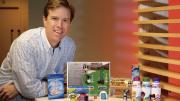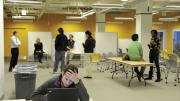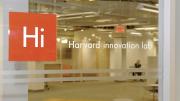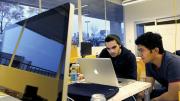The Harvard Innovation Lab—“Hi” in its cheery logo—was dedicated November 18. Located in Allston, it is adjacent to Harvard Business School (HBS), which not only paid to renovate and staff the former WGBH building at 125 Western Avenue, but is making the entire lab available to users throughout the University, and opening part of it to the surrounding community. The lab occupies the building’s first floor; the two upper floors have become team-based classrooms and project spaces for HBS’s new first-year field-immersion course (which involves students in hands-on business challenges and visits to host companies around the world this January).
In remarks before the ribbon-cutting, HBS dean Nitin Nohria called the facility a “promise” in two senses: a commitment to bring people together, and an expectation that great things can happen as people discover one another and advance their ideas “in this great cauldron, the i-Lab.” He saw the facility embodying “a wonderful spirit of ‘Why not?’ and ‘How about?’”
President Drew Faust noted that for 375 years, Harvard had been innovating—a continuous engagement with “using knowledge to invent the future.” Today, she said, “inspiration and aspiration” drove faculty members and students to work on problems like improving maternal and infant health. “Our history reminds us,” she said, “that the gap between the possible and the impossible,” between imagination and implementation, has been bridged regularly, and will be again and again in the future. In the new lab, Faust said, Harvard is “gathering great minds under a single roof, so they can become greater together.”
Mayor Thomas Menino hailed the lab’s community ties. Citing his city’s waterfront innovation district and large population of talented young people, he said, “Boston’s a place where big ideas are born, because we have the talent to make those ideas a reality.”
In the facility’s roughly 30,000 square feet of space, flexibly configured and furnished, “People can try out their ideas and see if they are worth putting to use,” says Joseph B. Lassiter, M.B.A. Class of 1954 professor of management practice, who is faculty chair of the lab.
The décor is contemporary entrepreneurial: exposed ceilings, ventilation, and wiring; bare concrete floors; surfaces coated with white-board paint to accommodate free-form recording of ideas; a kitchen stocked with refrigerated sodas, candy, and an adjoining large-screen TV with an Xbox Kinect game controller. There is a café for all-hours fueling, and a casually furnished lobby available to community users of the lab. Within the lab are a couple of dozen meeting rooms, a classroom, and a workshop to build prototype devices. Furnishings include wheeled folding tables that can be rapidly rearranged, ceiling-mounted electrical connections on pulleys that can be similarly deployed, and so on—accoutrements selected to promote “structured spontaneity,” in the phrase of Gordon S. Jones, the lab’s professional director.
Lassiter emphasized that Hi’s name—“lab”—was chosen deliberately. It is not a “center” or “institute,” he said in a conversation at his HBS office (where products of his students’ businesses are on display). The point is not to create a new curriculum or program, but to bring together and “accelerate” innovative and entrepreneurial energies from throughout the University. The lab—an alternative to inflexibly configured teaching spaces—“gives a place for a lot of the work to take place.”
So far, he noted, 15 entrepreneurs and experts in residence (13 from among HBS alumni) have been chosen, from many volunteers, to provide help in understanding venture finance, law, accounting, and subject-matter expertise. The lab’s workshops cover “tactical” subjects that complement course work—real-world knowledge, Lassiter said, that entrepreneurs need to test their ideas and pursue those that appear worthwhile.
What distinguishes the Harvard lab’s approach from those of other institutions’ entrepreneurship centers? First, Lassiter said, faculty members are involved from the outset—not just alumni and external practitioners. Second is the nature of the lab itself: it is explicitly experimental; those who use it are “under no pressure to commercialize an idea” that proves inappropriate for such development, or fails to hold interest. Third is the lab’s mandate to extend into the community—Allston and Brighton, whose residents will be invited to meet with small-business consultants, for example; and the world far beyond, wherever Harvard innovators are at work.
Together, he said, these traits make the lab “a fitting addition for an institution like Harvard.” One can read about the idea of bicycling, he said, but to master it, you have to get on the bike and practice. The lab, he hopes, will have a catalyzing role in accomplishing that, in part by “attracting the best students and faculty who regard innovation as central to their interests.”
Director Gordon Jones, who sets an informal tone for the lab, brings to his task long experience developing both freestanding businesses and innovations within a corporate context—ranging from mosquito-control services to a portable, disposable tooth-brushing product.
During a high-speed tour, he rattled off its core programs and facilities: classrooms for teaching; the experts in residence, mentoring for one to two days each a month; and the reconfigurable work spaces. Complementing these assets are flexible programs, such as entrepreneurship challenges; affinity groups formed around student interests (food-related entrepreneurship, for instance, or sustainable technologies); and i-Lab-originated programming. As users engage, the lab will, in effect, assemble its own community where none now exists.
Unlike entrepreneurship centers elsewhere, Jones said, the Harvard lab does not charge rent or extract ownership interests in user ideas. It is uniquely broad, and anti-“silo”—not tied to just the business school, or engineering—and therefore welcoming of entrepreneurial ideas in any realm (social innovation for education, health policy, better governance, et cetera). The entire impetus, he said, is “student-centered, faculty-enabled, and faculty-authorized.” The approach, echoing Lassiter’s vision, is of the “i-Lab as a farmers’ market” where users can browse, not a program in which one enrolls.
When the plans for the lab were announced in October 2010, it was described explicitly as a locus for “innovation and entrepreneurship” whether pursued independently or in conjunction with courses, such as the joint HBS-School of Engineering and Applied Sciences (SEAS) offerings on commercializing science. Teams competing in the annual HBS Business Plan Contest would have access to the resources, as would local businesses and entrepreneurs. Faust said then that innovation was “of utmost importance and great interest to our students and faculty, many of whom are inventors and entrepreneurs.” At least four streams feed the expanding pool of interest in innovation and entrepreneurship:
- M.B.A. pursuits. Although HBS is often perceived solely as a training ground for finance and corporate careers, the first-year required curriculum includes a semester course on “The Entrepreneurial Manager,” and the second-year elective curriculum includes, under entrepreneurial management, three dozen courses spanning a spectrum of subjects. Entrepreneurship appeals to many M.B.A. students.
- The rise of engineering. Further impetus comes from the rapid growth of the engineering and applied sciences, reflecting both the 2007 elevation of SEAS’s status to that of a freestanding school—making it more visible to students and more attractive to faculty recruits—and surging enrollments in exciting new fields like bioengineering. The Crimson reported that 12 percent of upperclassmen are now pursuing studies in those fields. New courses like “Medical Device Design” have engaged SEAS students with Harvard Medical School (HMS) faculty members and hospital practitioners to work on practical problems and create workable solutions.
- The Zuckerberg factor. With the rise of Facebook and other successful enterprises, entrepreneurship has regained some of the appeal that it had in the late 1990s. When Facebook founder Mark Zuckerberg ’06 visited campus earlier in November on a recruiting trip, he met with President Faust and was greeted like a rock star by a crowd of camera-wielding students. And for the first time, an HBS-created course is aimed squarely at undergraduates: United States and the World 36, “Innovation and Entrepreneurship: American Experience in Comparative Perspective,” held on the HBS campus and co-led by Lassiter and Mihir A. Desai, Mizuho Financial Group professor of finance.
- The competition. Finally, Harvard is responding to pressure from peer institutions. MIT has a long, deserved reputation for fostering engineering-based business start-ups; its Entrepreneurship Center (directed by Bill Aulet ’80) offers a wide array of events and programs for students and alumni, and is tied into dozens of management and venture-oriented engineering courses. Stanford is perceived as having especially entrepreneurial DNA: its president, John Hennessy, was a spectacularly successful entrepreneur, and is a director of the Stanford-born Google; it has risen along with Silicon Valley; and it is widely known for academic programs that foster innovation, such as its Hasso Plattner Institute of Design (the “d.school”). Stanford is competing to establish a high-profile new engineering and innovation campus in New York City; and its Graduate School of Business recently received a $150-million gift to establish a Stanford Institute for Innovation in Developing Countries, meant to help alleviate poverty.
Harvard’s development office has thus made innovation a major theme in emerging plans for the next capital campaign. Students and faculty members are taking note, too: Hi has scheduled a January trip to Silicon Valley to visit, among other facilities, the Stanford offerings and IDEO, a famous innovation consulting firm whose founder and chair, David Kelley, runs the d.school. IDEO partner Diego Rodriguez, M.B.A. ’01, a d.school founding professor, is one of the HBS/innovation lab entrepreneurs in residence. Harvard clearly wants to compete with some of the other leading academic centers of innovation and entrepreneurship.
In concluding her remarks at the dedication ceremony, President Faust invoked a different sort of Harvard innovator—George Santayana, A.B. 1886 (summa cum laude, no less), Ph.D. ’89—quoting his 1908 essay, “Hamlet”:
Imagination needs a soil in history, tradition, or human institutions, else its random growths are not significant enough and, like trivial melodies, go immediately out of fashion.
The soil of Harvard and of Boston, she said, had long provided, and would continue to provide, a suitable foundation for the fruits of the imagination now nurtured in the i-Lab to flourish.












